The Perfect Chill: Understanding Refrigerator Temperature
How cold is it in a fridge? The ideal refrigerator temperature is between 35°F and 38°F (1.7°C to 3.3°C), with 37°F (2.8°C) being the optimal setting. Your freezer should be set at 0°F (-18°C).
| Refrigerator Section | Ideal Temperature | Safe Range |
|---|---|---|
| Main compartment | 37°F (2.8°C) | 35-38°F (1.7-3.3°C) |
| Bottom shelf | 1-2°C (33-36°F) | Coldest zone - best for meat |
| Door shelves | 3-4°C (37-39°F) | Warmest zone - condiments only |
| Crisper drawers | 2°C (35.6°F) | Separate humidity settings |
| Freezer | 0°F (-18°C) | Below freezing |
Just like Goldilocks, your refrigerator likes things not too hot and not too cold. Setting your fridge at the proper temperature is critical for food safety and preservation. When temperatures rise above 40°F (4.4°C), you enter the "danger zone" where harmful bacteria multiply rapidly, potentially causing foodborne illness. Too cold (below 32°F/0°C), and your fresh produce might freeze and lose quality.
I'm Mortuary Cooler, a national supplier of temperature-controlled storage systems with experience in maintaining precise temperatures for both commercial and residential applications, including how cold is it in a fridge environments where exact cooling is critical. My background in refrigeration technology helps me understand the importance of maintaining consistent temperatures to preserve contents and prevent spoilage.
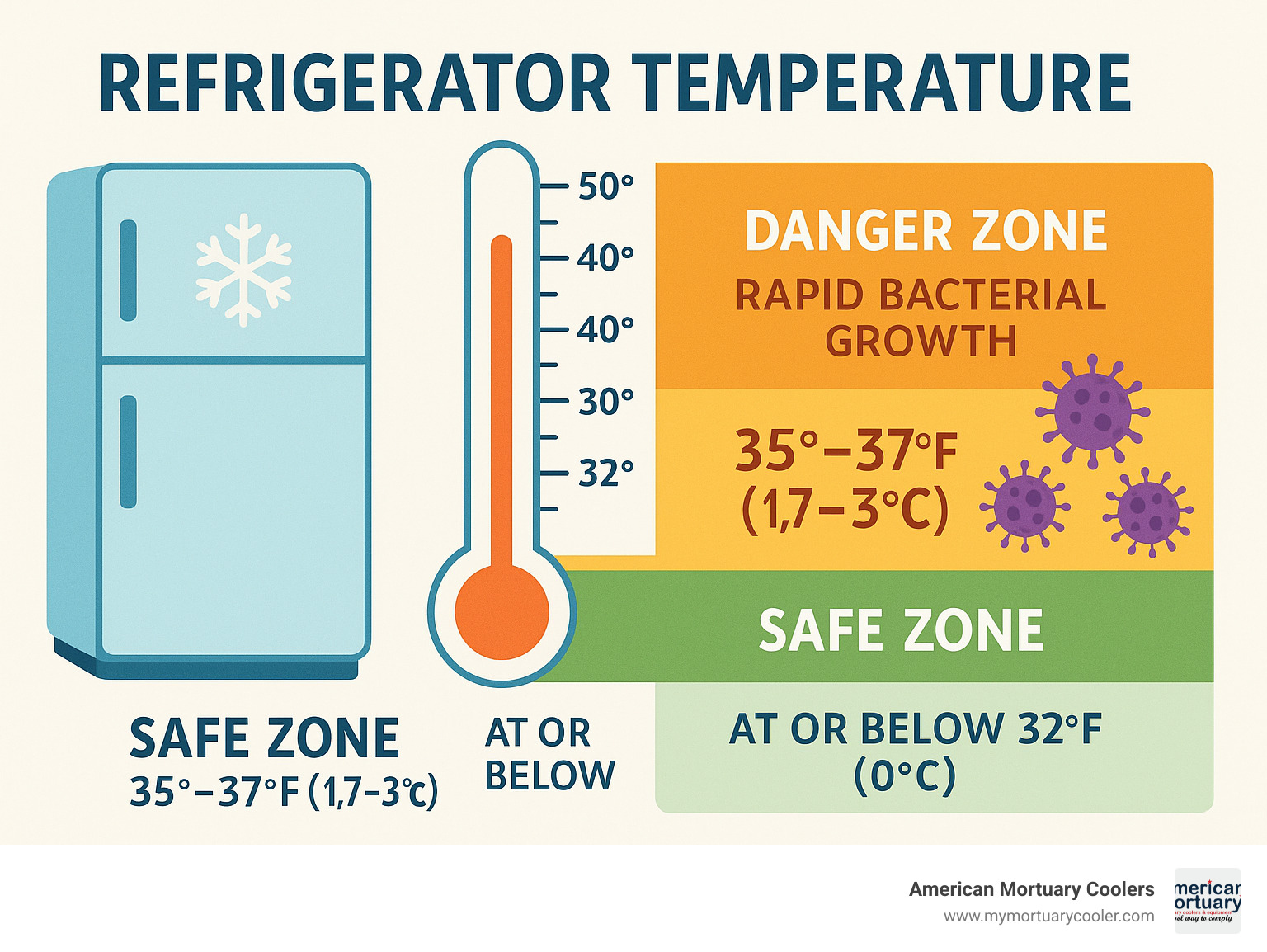
Know your how cold is it in a fridge terms:
How Cold Is It in a Fridge
When it comes to how cold is it in a fridge, there's actually a sweet spot that keeps your food fresh without freezing it. The FDA recommends keeping your refrigerator at or below 40°F (4.4°C), but for optimal food preservation, aim for between 35°F and 38°F (1.7°C to 3.3°C).
This narrow temperature window isn't arbitrary – it's carefully calculated to give you the best of both worlds. Cool enough to significantly slow down bacterial growth (which helps keep your family safe), but not so cold that your lettuce and berries turn into sad, frozen versions of themselves. At 37°F (2.8°C), you've hit the bullseye for most refrigerators.
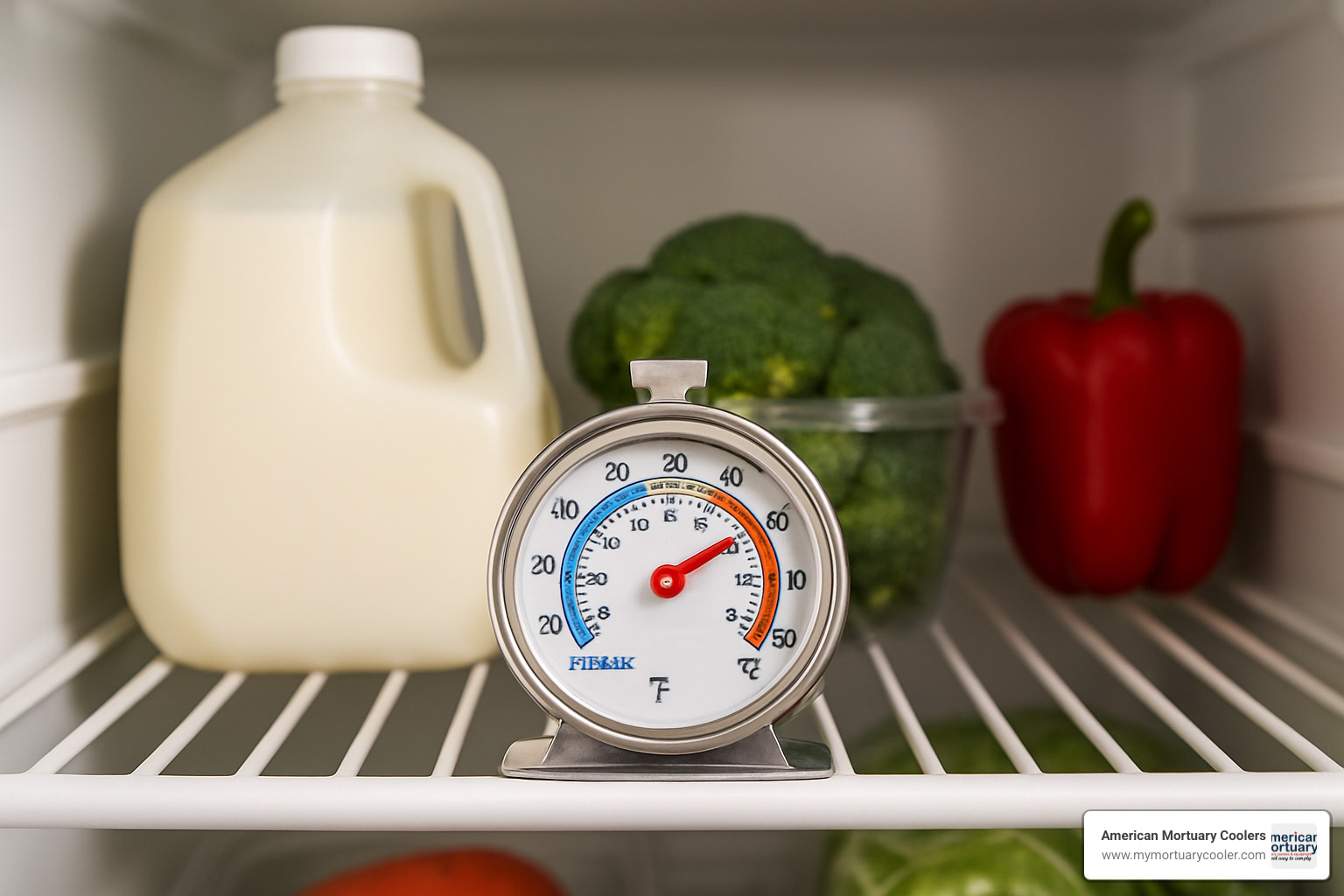
One thing to remember – that built-in temperature display on your fridge? It might be fibbing a bit. These factory gauges can be off by several degrees, which is why having a separate refrigerator thermometer is worth the small investment. Think of it as a fact-checker for your fridge!
We at American Mortuary Coolers understand temperature precision better than most – after all, consistent cooling is our bread and butter. While we typically focus on specialized cooling systems, the same principles apply to keeping your household foods safely chilled.
How cold is it in a fridge for everyday use
For your day-to-day refrigeration needs, keeping temperatures between 35°F and 38°F (1.7°C to 3.3°C) hits that perfect balance of food safety and energy efficiency. At about 37°F (2.8°C), your milk stays fresh longer, your vegetables remain crisp, and harmful bacteria remain in hibernation mode.
If your fridge has a numbered dial (usually 1-7 or 1-9), the middle settings typically land you in this ideal range. For a fully stocked fridge, aim for 3-4; if yours is running on the emptier side, 2-3 usually does the trick. Those fancy digital models make it even easier by letting you set the exact temperature.
Did you know a well-stocked fridge (about 80% full) actually maintains temperature better than an empty one? All those chilled items act like cold batteries, helping stabilize the internal environment. Just try not to stand there with the door open deciding what to eat – each opening allows cool air to escape and warm air to sneak in.
Your refrigerator works hardest right after you've loaded it with room-temperature groceries or when the kitchen heats up during summer months. Give it time to catch up, and try not to panic if the temperature rises temporarily after a big shopping trip.
How cold is it in a fridge versus freezer
There's a world of difference between how cold is it in a fridge compared to your freezer. While your refrigerator maintains a cool 35-38°F (1.7-3.3°C), your freezer needs to bring the serious chill – specifically 0°F (-18°C) – to properly preserve frozen foods.
| Feature | Refrigerator | Freezer |
|---|---|---|
| Ideal Temperature | 37°F (2.8°C) | 0°F (-18°C) |
| Safe Range | 35-38°F (1.7-3.3°C) | 0°F to -10°F (-18°C to -23°C) |
| Purpose | Slow bacterial growth | Stop bacterial growth completely |
| Food Storage Time | Days to weeks | Months to years |
| Risk if Too Cold | Food freezes, texture changes | Excessive frost buildup, energy waste |
| Risk if Too Warm | Rapid bacterial growth, spoilage | Partial thawing, refreezing, quality loss |
| Power Outage Safety | 4 hours (door closed) | 24-48 hours (full freezer, door closed) |
These different temperature zones serve distinct preservation purposes. Your refrigerator works like a time-slowing device, dramatically reducing bacterial growth without completely stopping it. It's perfect for keeping foods fresh for days or weeks while maintaining their textures and flavors.
Your freezer, meanwhile, is more like a pause button. At 0°F, it essentially stops bacterial growth in its tracks and significantly slows the enzymatic activity that causes food to deteriorate. That's why properly frozen foods can last months or even years rather than days.
Here's a fun freezer temperature test: check your ice cream. It should be firm but scoopable. If you need a chisel to get it out, your freezer might be running too cold (and wasting energy). If it's soft and melty, time to adjust the dial cooler.
At American Mortuary Coolers, we're particularly attuned to the importance of maintaining precise temperatures across different cooling environments. Whether it's preserving food in your home refrigerator or our specialized cooling applications, getting the temperature just right is the key to effective preservation.
Food Safety & Spoilage: Why Temperature Matters
Ever wondered why how cold is it in a fridge matters so much? It's not just about keeping your milk from going sour—it's about keeping your family safe. The FDA has identified temperatures between 40°F and 140°F (4.4°C and 60°C) as the "danger zone" where harmful bacteria throw a multiplication party, potentially doubling their numbers every 20 minutes when conditions are just right.
When your refrigerator creeps above 40°F (4.4°C), you're essentially rolling out the red carpet for unwelcome guests like Listeria, Salmonella, and E. coli. These foodborne troublemakers can quickly reach levels that might leave you or your loved ones seriously ill.

Temperature truly is the master control for bacterial growth. At 50°F (10°C), bacteria double approximately every 10 hours—not great for your leftovers. At 40°F (4.4°C), we start to see bacterial growth significantly slow down. Drop to 37°F (2.8°C), and bacterial activity becomes minimal (though not completely stopped). Only when we hit freezing at 32°F (0°C) and below does bacterial growth essentially halt—though it's worth noting this doesn't kill existing bacteria, it just puts them into hibernation.
This is precisely why that sweet spot of 35-38°F (1.7-3.3°C) gives you a crucial safety buffer below the 40°F danger threshold. Think of it as your insurance policy against foodborne illness.
Power outages bring this knowledge into sharp focus. According to USDA guidelines, a closed refrigerator will maintain safe temperatures for about 4 hours during an outage. Your freezer fares better—a full freezer keeps foods safely frozen for approximately 48 hours (24 hours if it's only half-full), provided you keep that door firmly shut.
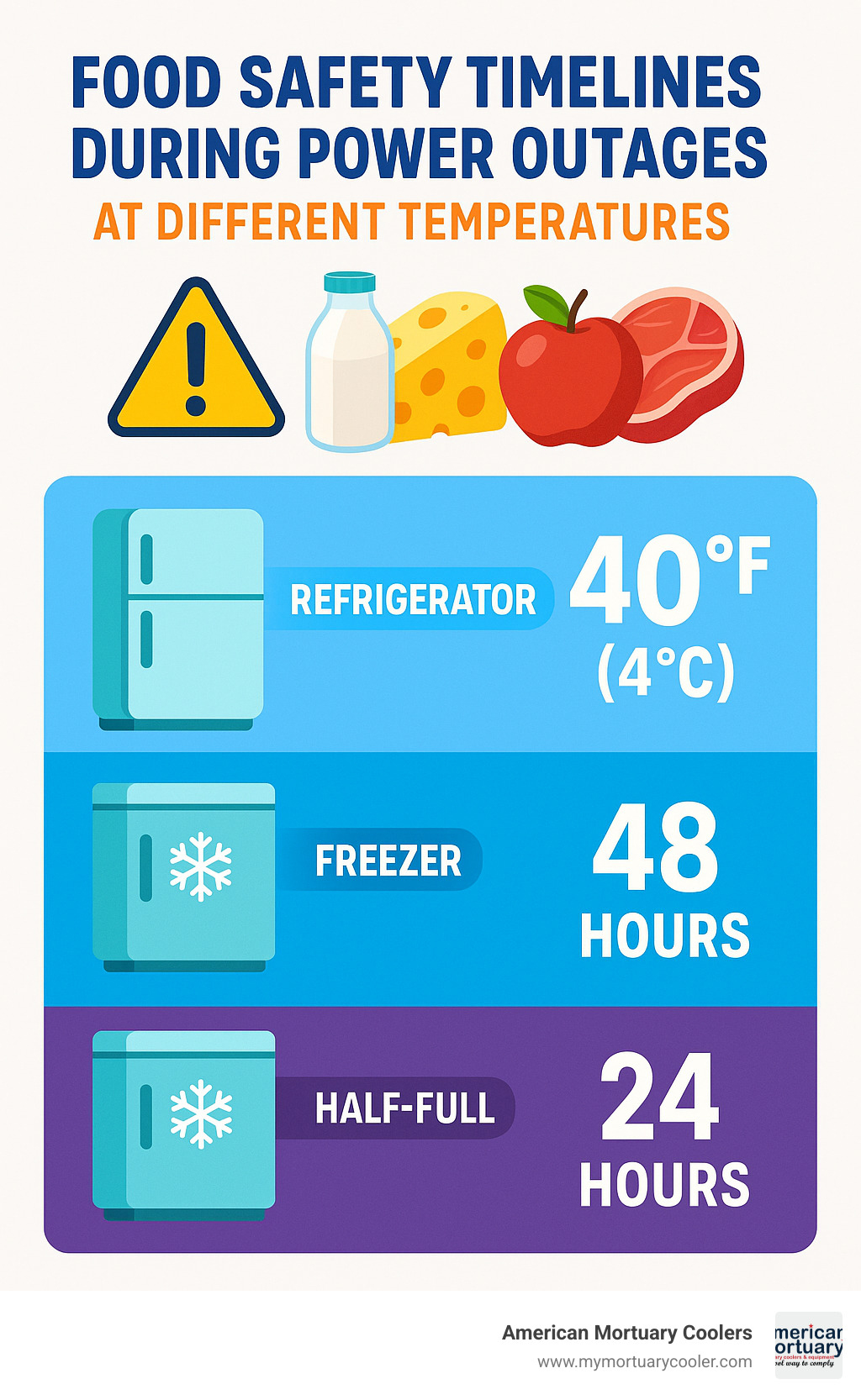
At American Mortuary Coolers, we understand temperature control isn't just a technical specification—it's a safety essential. While our daily work focuses on mortuary refrigeration systems, we apply the same unwavering principles of consistent temperature control that keep your family's food safe in your kitchen refrigerator.
For those who want to dive deeper into food safety best practices, the FDA provides comprehensive resources on safe food storage that are well worth bookmarking.
When it comes to refrigeration, those few degrees make all the difference between safely preserved food and a potential health hazard. Keeping your fridge at the right temperature isn't just good housekeeping—it's good health protection.
Measuring, Troubleshooting & Maintaining Correct Temperatures
Knowing how cold is it in a fridge is just the beginning—making sure your refrigerator actually maintains that temperature consistently is where the real challenge lies. After all, what good is knowing the ideal temperature if your fridge can't keep it steady? Let's explore how to monitor, fix, and organize your fridge for optimal cooling.
How to measure temperature accurately
Want to know exactly how cold is it in a fridge? Don't just trust the dial. Those built-in thermostats can be off by several degrees, which makes a big difference when we're talking about food safety.
The most reliable method I recommend is the glass-of-water technique:
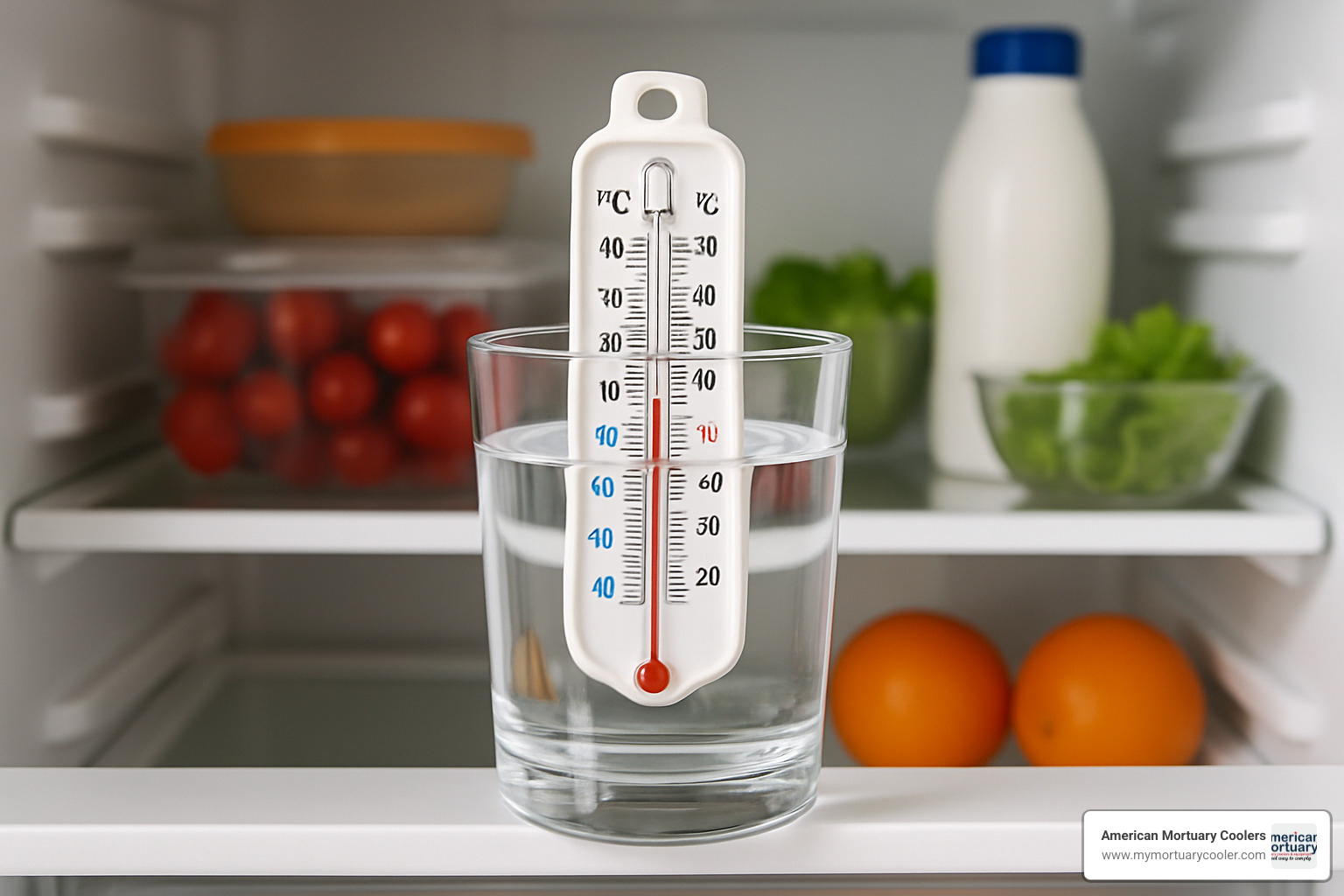
Simply place a thermometer in a glass of water, set it in the middle of your fridge, and leave it overnight (at least 8 hours). Check the reading without removing the thermometer from the water. This clever approach measures the temperature of what really matters—your food—rather than just the air, which fluctuates every time you open the door.
For older fridges that might have cold and warm spots, try using two thermometers—one at the top-back (typically coldest) and another near the door (usually warmest). For freezers, nestle the thermometer between frozen items or place it in a small cup of cooking oil, which won't freeze solid and will give you a more accurate reading.
Fixing a fridge that's too warm or too cold
Is your milk spoiling too quickly? Or maybe your lettuce is freezing? Let's troubleshoot those temperature issues.
When your fridge is running too warm, start with the obvious: check and adjust the thermostat to a colder setting. Next, take a peek inside and make sure food isn't blocking those critical air vents. A blocked vent is like putting a hand over your mouth—nothing good comes from it!
The door seal might also be the culprit. Try the dollar bill test—close the door on a bill and if you can easily pull it out, your seal needs attention. Don't forget those condenser coils (usually hiding behind or underneath the fridge)—they collect dust like a magnet, making your fridge work harder and less efficiently.
For fridges that are too cold, the fix is often simpler. Adjust the thermostat to a warmer setting and check that the temperature control damper is working properly. Sometimes the thermostat sensor touches the back wall, which can cause inaccurate readings and over-cooling.
If you've tried everything and your fridge still can't make up its mind about how cold is it in a fridge, it might be time to call in a professional. At American Mortuary Coolers, we understand that consistent cooling is non-negotiable, whether you're storing groceries or working in specialized environments.
For those curious about the inner workings of cooling systems, our guide on Refrigeration System 101: Understanding the Basics breaks it down. And if your freezer is giving you trouble, check out Beginner Freezer Temperature Mistakes and How to Avoid Them.
Organizing food for consistent cooling
Your refrigerator isn't just one temperature throughout—it has microclimates! Understanding these zones helps you store food where it belongs, keeping everything at its perfect temperature.
The coldest spots in your fridge (35-36°F/1.7-2.2°C) are typically the bottom shelves and the back of middle shelves. This is prime real estate for raw meat, poultry, and fish. Always keep these items in sealed containers to prevent any unwelcome dripping onto other foods.
The middle zone (36-38°F/2.2-3.3°C) is perfect for dairy products, eggs, prepared dishes, and last night's leftovers. These items need consistent cold but not the coldest temperatures your fridge offers.
Your door shelves run warmer (38-40°F/3.3-4.4°C) because they're exposed to room temperature every time you open the fridge. Reserve this space for condiments, jams, and juices that aren't as temperature-sensitive. Despite what you may have seen in countless movies and TV shows, milk and eggs should never live in the door!
Don't forget about those specialized drawers. Your crisper drawers often have humidity controls—high humidity for leafy greens that wilt easily, low humidity for fruits and vegetables that emit ethylene gas. That meat/deli drawer? It's actually designed to be slightly colder than the main compartment, making it perfect for lunch meats and cheese.
For the best cooling efficiency, avoid the temptation to pack your fridge to the brim. Leave about 20% of space empty for proper air circulation—think of it as giving your food some breathing room. And while it's tempting to put hot leftovers straight into the fridge, let them cool for a bit first (but never leave perishable foods out for more than 2 hours).
At American Mortuary Coolers, we apply these same principles of organized storage and airflow management in our commercial cooling systems. After all, whether you're storing groceries or working in specialized environments, the fundamentals of good refrigeration remain the same—maintain the right temperature consistently throughout the entire space.
Frequently Asked Questions about How Cold It Is in a Fridge
Is 37°F cold enough for my fridge?
Absolutely! 37°F (2.8°C) hits the sweet spot for refrigerator temperature. Think of it as the Goldilocks zone – not too warm, not too cold, but just right. At this temperature, those pesky bacteria slow way down, but your lettuce and herbs won't accidentally freeze and turn to mush.
When your fridge maintains this ideal temperature, you're creating a nice safety buffer below that critical 40°F mark where bacteria start throwing a multiplication party. Your milk stays fresh longer, your leftovers remain safe, and your produce maintains its crisp texture.
If you're storing lots of raw seafood or preparing for a big event, you might want to dial things down to 35-36°F in your meat drawer specifically. But for everyday use? That 37°F setting strikes the perfect balance between keeping food safe and preserving its quality and flavor. Your strawberries will thank you!
How long will food stay safe during a power outage?
We've all been there – the lights flicker, then darkness. Now you're wondering about everything in your fridge. Here's the good news: a closed refrigerator acts like a cooler, keeping food safely cold for about 4 hours according to USDA guidelines. Your freezer is even more resilient – a full one maintains safe temperatures for roughly 48 hours when left unopened (24 hours if it's half-empty).
The key to weathering a power outage is preparation and minimal door opening. Each time you peek inside, precious cold air escapes. If you know bad weather's coming, consider freezing some water containers to create ice blocks that help maintain the chill.
When power returns, don't just assume everything's fine. Use a food thermometer to check if items stayed below 40°F. Remember this simple rule: if perishable foods have been above 40°F for more than 2 hours, it's safer to toss them than risk foodborne illness.
For extended outages, dry ice works wonders – about 50 pounds will keep a full 18-cubic-foot freezer cold for approximately two days. At American Mortuary Coolers, we understand how critical temperature stability is, which is why many of our commercial systems include backup power options for peace of mind.
What foods are most sensitive to temperature changes?
Not all foods are created equal when it comes to how cold is it in a fridge. Some items are temperature divas, while others are more flexible.
Your most temperature-sensitive foods need that consistent 35-38°F environment. Raw meats, fish, and poultry fall into this category – store them on the bottom shelf where it's coldest (and where any drips won't contaminate other foods). Fresh milk, soft cheeses, and eggs also demand this consistent chill, as do prepared foods and deli meats.
Some foods actually suffer when they're too cold. Those beautiful leafy greens can freeze and turn into a slimy mess if placed in the back of the fridge. Fresh herbs might blacken, and tomatoes lose their flavor complexity and develop that mealy texture we all dislike when stored below 41°F. Tropical fruits like bananas and avocados develop brown spots when chilled too much, and potatoes stored below 45°F convert their starches to sugar, which affects how they cook.
For best results, use your refrigerator's specialized zones as intended. The crisper drawers typically let you control humidity levels – use high humidity for leafy greens and low humidity for fruits and vegetables that release ethylene gas. The meat drawer maintains a slightly colder temperature, perfect for extending the freshness of raw animal products.
At American Mortuary Coolers, we apply these same principles of temperature sensitivity in our specialized cooling systems, recognizing that different materials require different preservation environments for optimal results.
Conclusion
Understanding how cold is it in a fridge might seem like a small detail in your daily life, but it's actually the cornerstone of food safety, meal planning, and reducing waste in your home. That sweet spot of 35-38°F (1.7-3.3°C) is your golden ticket to keeping food fresh without freezing your lettuce or letting bacteria throw a party on your leftovers.
Throughout this guide, we've explored the ins and outs of refrigerator temperatures, and here's what matters most: your main fridge compartment should hover around 37°F (2.8°C) – not too cold, not too warm, but just right. Your freezer needs to maintain a chilly 0°F (-18°C) to keep those frozen goods in prime condition for months.
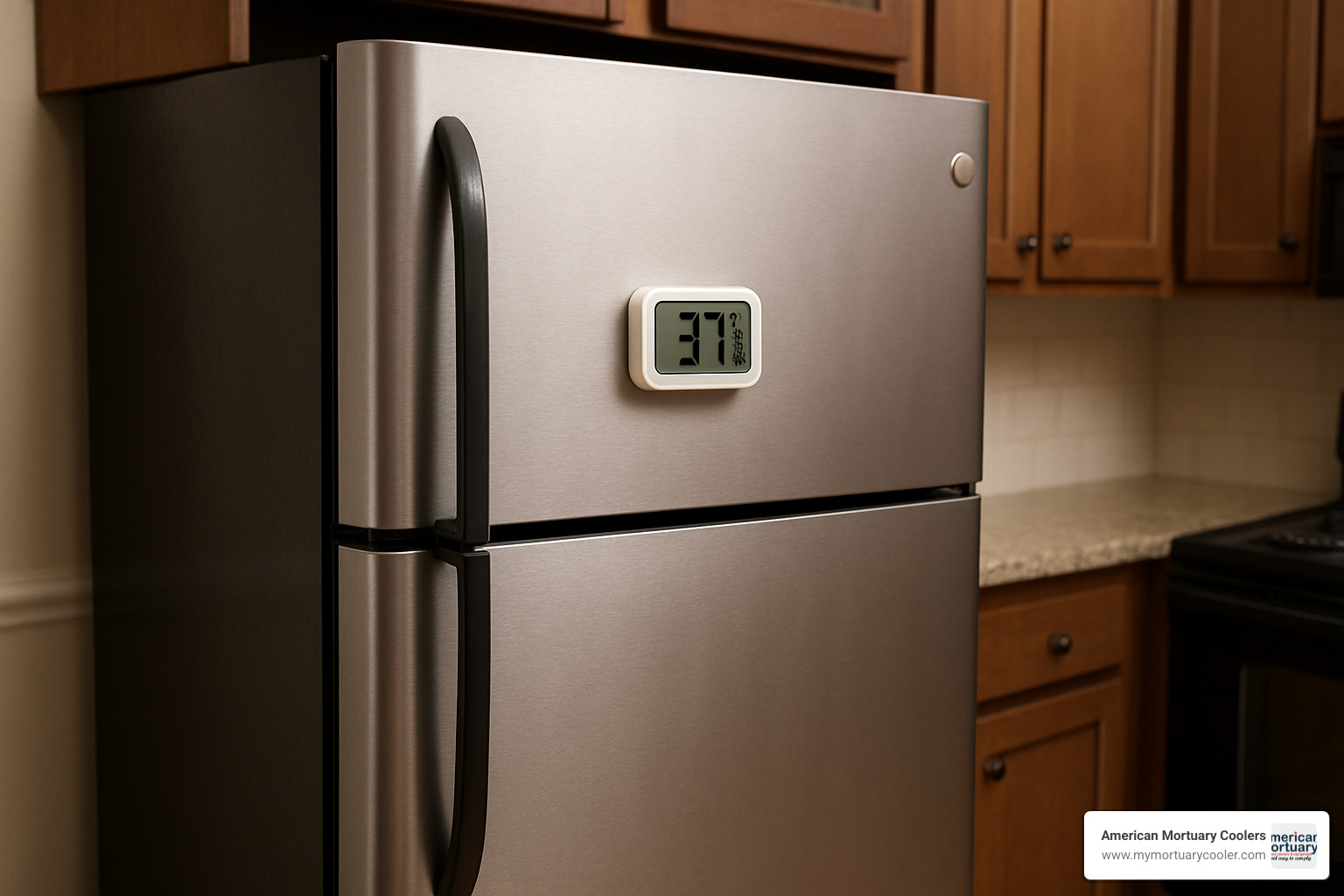
Don't trust the dial on your fridge to tell the whole story – invest in a simple appliance thermometer to know for sure what's happening inside. The few dollars spent here can save hundreds in prevented food waste. Remember to organize your foods strategically, keeping delicate items away from the coldest spots and storing meat in its designated drawer.
When those inevitable power outages strike, keep calm and keep those doors closed! A well-sealed refrigerator will maintain safe temperatures for about 4 hours, while a full freezer can go an impressive 48 hours before things get dicey.
And don't forget the maintenance basics that keep your cooling system running efficiently: clean those condenser coils periodically, check door seals for leaks, and ensure proper airflow around your stored items. These simple habits not only extend the life of your appliance but also keep your energy bills in check.
At American Mortuary Coolers, we're passionate about temperature control – it's the heart of what we do. While our day-to-day work focuses on specialized cooling solutions for the funeral industry, we understand that the principles of effective refrigeration remain consistent whether you're preserving tonight's dinner ingredients or addressing more specialized needs.
Temperature precision isn't just a technical detail – it's what stands between fresh, safe food and waste or illness. With the knowledge from this guide, you're now equipped to maintain that perfect chill in your kitchen's most hardworking appliance.
For those with specialized cooling needs beyond the kitchen, explore more info about our one-stop mortuary cooler solutions.
Remember – when it comes to refrigeration, getting the temperature just right isn't being picky, it's being smart. Your food will last longer, taste better, and keep your family safer. Now that's something worth chilling about!
















